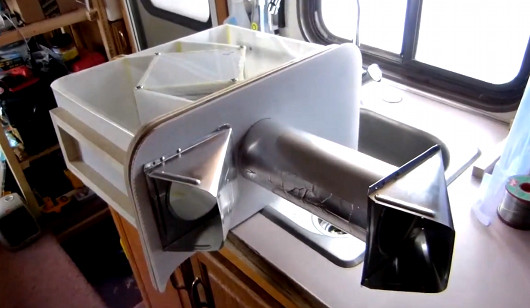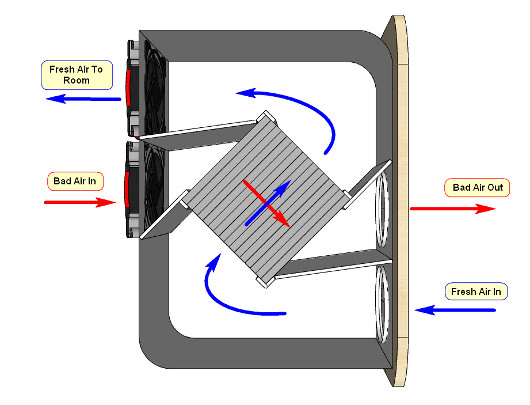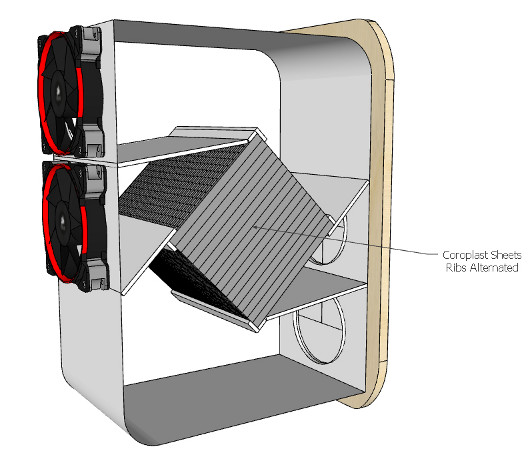When snow covers the landscape outside, you do your best to preserve the heat inside. [Tom] came up with a smart design for a solder fume extractor that includes a heat recovery ventilator. He created a housing which contains input and output sections. A fan is used to bring in outside air, passing it through a heat exchanger made of alternating panels of coroplast. (See diagrams of his setup after the break) This is really a simple design, and could be built in a couple of hours.
A little digging turns up some good information on making a heat exchanger like this one. [Tom] doesn’t mention the indoor temperature, so it’s difficult to calculate the efficiency he’s getting out of it. Apparently they can attain up to 70% heat transfer, depending on the size of the heat exchanger.
In the video, [Tom] mentions some obvious improvements that could be made, including more efficient fans, and a better housing that allows the core to be removed for cleaning. Still, this is a simple setup that provides a good proof of concept. Perhaps we’ll get to see a more permanent installation from [Tom] in the future.


















Oh, great idea. Use the exhaust air to heat the incoming air. I need to make a big one of these for my grow room.
Ha HA! I can feel the gears working in many minds out there right now!
HRV’s are also used for humidity control in bathrooms etc.
Switch on when the humidity gets too high etc.
Ebay and Amazon have many humidity sensor boards and controllers.
Like these:
IMAGE® Digital Air Humidity Controller Sensor WH8040 Measuring Range 1%~99% AC 110V – Amazon.com – http://is.gd/ppivmt
It’s the companion to the STC-1000 temp controller everybody uses:
All-purpose Temperature Controller STC-1000 With sensor – Amazon.com – http://amzn.com/B00862G3TQ
I want ready made COTS parts 12v versions of these. So it will all run “off-grid”.
Oh…ZooMed makes a combo temp/humidity (AC only?) controller for reptiles:
http://www.amazon.com/Zoo-Med-HygroTherm-Temperature-Controller/dp/B0019IHK9Q/ref=pd_sim_sbs_hi_7
Can probably get these walk in retail at major pet shops.
Won’t work with computer fans…but there are many small AC fans out there.
Desk fans, small centrifugal blowers etc.
Cross-airflow? I thought the way to may a heat recovery system was anti-parallel airflow?
This makes the design much simpler though, since the two air streams just pass through the heat exchanger block in different directions, no complicated ducting needed.
Corrugated aluminum panels would have been much more efficient than coroplast though.
Many commercial (I mean branded residential units) HRV’s use coroplast and are set up for cross flow, as this one is. The commercial units add a couple of filters, drain pan, as wall as more reliable, motors. They usually have control for operations to control speed/humidity and dampers to reduce frost build up.
Good call using an insulator for the heat transfer. FFS.
That was my concern, but a quick search reveals that corrugated aluminium core is available. Perhaps this would be more effective.
Calm down, I have seen plenty of commercial heat recovery ventilation systems using coroplast/correx heat exchangers.
I am calm. See, this is my calm face.
You know what my foundational motto is?
It’s from Buckminster Fuller.
“Dare To Be Naive”
It pays off. Believe me ;)
Coroplast insulates because of the air that is held in it. So in his scenario, it’s not an insulator anymore.
Sure the air is a large portion of the insulative properties, but you also have to think of thermal conductivity.
The polypropylene sheet that makes up the Coroplast is about 0.240 – 3.40 W/m-K, whereas an Alumalite sheet should be around 210 W/m-K
http://www.8020.net/Quick-Frame-30.asp
Nice stuff. But….pricing? Spendy. I think it’s $100 a 4×8 sheet?
I’ve had trouble buying even Coroplast from sign shops in my small town of 50,000.
One guy has Alumilite but prob. thinks it’s solid gold.
Home Depot with 3×6 sheets in stock is a lifesaver!
Once you get the Alumilite, you have to cleanly saw it then bond the sheets together.
MANY sheets. My 6″ x 6″ x 7″ thick core is approx. 50-60 “squares” glued together. Spray adhesive might work for Alumilite. Dunno what spray adhesive would work on Coroplast. My Harbor Freight/Ad Tech hot glue gun with wide nozzle worked great. Higher temp hot glue works perfect with Coroplast. Though you need to move fast when applying the glue thinner.
Agreed. You really need to look at the overall cost vs efficiency gain for things like this.
Still looks cheaper than simply getting a similar sized heat exchanger though.
Nearly 3 years too late! But for the record, the conductivity of the material has negligible affect when the material is so thin. Even the best insulator conducts heat more than well enough. https://edavies.me.uk/2014/03/mhrv-req/
Link is to wrong part of conversation. Try this – https://edavies.me.uk/2014/03/mhrv-area/
The static comb style Heat recovery systems rarely exceed 50% efficiency, While the rotary disk style heat recovery systems can reach efficiency close/up to 80%. Maybe the people writing the topics should do a little research before making wild claims ;D
The “claims” are made by many manufacturers. None of us have had time to get exact facts and figures. Mitsubishi claims 70% on their paper cores. I’m ok with that. I’m sure they know what they are doing. If I get 50%…hell, that’s better than *none*.
Besides, I was all out of rotating disk UFO technology ;) All I had was a lone unused sheet of Coroplast calling my name. It got the job done!
My comment was towards the editors, please learn to read peoples comments thoroughly before replying. Thank you.
He can defend the editors if he wants to…
Rotating-disk exchangers also introduce some cross-contamination, which kinda defeats the purpose.
Depends on how you build it, You would need filters anyway. So why would one build it without a filter.
If your so concerned with heat loss, why not use just a smoke filter recirculating air? unless the mighty soldering iron is throwing enough joules into this transfer to not want to waste, which its not…
Ditto. While this is a cool use of the coroplast stuff, I really don’t see the point. I have used those activated carbon filters in the past to remove solder fumes – they work a treat, and you could just recirculate the air into the room. If you’re worried about quantity, use a cooker hood filter! In fact, why not just use a cooker hood…..
None of those filters actually do much. Activated carbon only removes the smell.
There are many other hazardous components to solder smoke.
Remember, in a commercial building where they use carbon filter solder fume extractors, they also have big central building ventilation (and prob. an HRV on that if they are smart!)
If you fire up a 100 cfm fan sucking fumes outdoors…there is 100 cfm of cold air being pulled into your house *somewhere else*.
I can remove any type of fumes pretty much and get nice clean fresh (warm!) air in return. It’s like having a window open and not losing any heat outdoors. Deluxe…man…deluxe ;)
I feel stupid but I don’t get it. What’s the difference between using warm air from inside to heat cool air from outside inside a box and using warm air from inside to heat cool air from outside inside a room?
Well he wants to get the solder fumes out of the room…if the warm air from inside the room wasn’t full of toxic fumes you’d be right, it would be pointless.
He’s venting the dirty, warm air to the outside. If just vented, the heat in the warm air is wasted. Instead, he’s pulling the heat out of the dirty, warm air (by heating up the incoming clean, cold air) before it gets vented, thus saving some energy.
http://cipco.apogee.net/ces/library/tdew.asp
Enthalpy & Heat Wheels
Ahh yeah…only problems are:
“requires that the air streams must be relatively clean and may require filtration”
“results in some cross-contamination (mixing) of the two air streams, which occurs by carryover and leakage.”
My core is sealed completely if you make it properly.
The two air streams never physically touch.
Use a little silicone on the “brackets” that hold the core in for total security.
First time I switched mine on…I had a leak due to hot glue not covering a seam all the way. My designed box was a bit too small as I only had one 3′ x 6′ sheet of Coroplast.
Hence, I didn’t have room for the large 100w hot glue gun to get all spots easily.
Test airflow with a bunch of smoky incense, cigar, whatever.
You should not smell much at all on the incoming air port. Some wafts around outside though probably.
Another way to test would be to use a few dryer vent tubes at first.
Separate the outside facing air input/outputs by a number of feet and do the smell test at the far end of the hose.
I’ll detail all this in the upcoming video.
What’s the best *really smoky* brand of incense?
Can I order colored smoke bombs off Amazon? ;)
BTW the room temp was very close to the output thermometer reading.
I’m going to get more temp sensors for my full how-to video coming up.
HRV units work….and work well. As you can see in the video.
It’s a “fancy” heat recovering vent.
Does not matter that Coroplast is a supposed “insulating” material (it ain’t Aerogel!).
This idea of using a Coroplast core has been around since the 80’s:
http://www.builditsolar.com/Experimental/DIYHRV/DIYHRV.htm
There are many commercial units that use Coroplast.
Mitsubishi patented a different resin coated paper core. Search “Mitsubishi Lossnay”.
Now, since we don’t have easy Home Depot access to fancy treated paper I used Coroplast. Each layer of the core must be sealed to the others. I applied high temp yellow hot glue in a thin layer all around the “square”. This took a long time!
If the core sheets are not sealed, it won’t work right. You don’t want recycled fumes right back in your room. Don’t know what you are going to bond individual sheets of aluminum core with easily, especially 3 square feet of them (or more!). That might be way more work than it’s worth.
I’ve always used a computer fan with outdoor vent tube to remove solder fumes from the spot I’m working in. There is no good reason to breathe any of this stuff in. I mean why would you when you have the technology to remove them ;)
Now the last (mental) barrier has been removed for people. A (under $100) DIY “single sided” HRV that can fit in the smallest window.
The next one I build will be from thin plywood with epoxy coated interior.
Going to have a sealed access hatch for the core (for cleaning).
Will also use high static pressure Scythe Gentle Typhoon fans (“high speed” 3000 rpm versions) with speed controllers. I want to dial down the incoming air a little bit as the flow through my design is more free through that channel.
Once you build one of these…you’ll wonder why you didn’t do it way sooner!
Love it, will probably build one as well in the future!
Timely topic. I tore down my broken Electrolux and salvaged the blower (sucker?) with the intent to build a fume extractor. Any one already puzzle through how to do something like this with a single blower?
Sorted it out – air pressure handles the fresh air inlet. One fan is all you need.
Give it a try! I’d like to see a handheld anemometer or flow gauge show the incoming air speed. In a leaky home you may not see as much airflow coming through the unit. The air has other places to come in from. In a small room with door closed and a towel under the bottom one fan may indeed work. Commercial HRV’s use dual fans because they have long ductwork at the 4 ins/outs.
Quite right – we have a wood stove that draws pretty readily in our “air tight” home. :-) Bathroom vents account for most of that I think. Running the inlet duct to a location near the exhaust hose, be it near the soldering station or on the paint hood might ensure a pretty good draw from the nearest source.
Definitely plan to do this on Christmas break.
Just don’t get high…on your own supply!
An HRV has been on my to-do list for some time now, especially for a bathroom. I can imagine that this will cause condensation in the heat exchanger. This is good, because that releases heat, but bad because the water will build up and I wouldn’t want it to get mold in there.
On the other hand, only the out-bound air should come into contact with it, so it might not even be a problem at all (unless conditions reverse in summer).
Who solders under a fumehood? I personally don’t even use a fan, just crack a window after soldering and that’s it.
truth be told, I don’t even do that. my house is 100 years old and WAAAY to drafty.
This is an awesome build, I honestly wouldn’t have thought that plastic would be able to conduct heat so easily, but without the air gap, it doesn’t do well as an insulator. Now all he needs to do is put a drain for any condensation that he WILL get when he has excessive humidity to deal with, and put the fans on the outside of the unit to dampen the noise, but other than that he’s got it, I would keep it made out of plastic just for the weight aspect of it. And this makes a lot of sense in a (is that a camper he’s using) home like this, if you don’t have make up air from an exhaust fan, you’ll be pulling it through every little nook and cranny without the heat recovery.
First I have to say, well done.. it looks really nice.That said, I would do at least two things quite differently. I think the core should be higher and the partitions for the core should go out in the horizontal and vertical planes, so as to give both airflows a clearer path having fast flowing air make 90 degree turns reduces the airflow. Visualize a simple X with the supply and return on both sides as close to the coressponding part of the core.Its important to separate both the interior and exterior vents to prevent the just exhausted air from being recycled into the house. I have an HRV, its a fantech model, and thats how its designed, it has an aliminum core thats made out of aluminum sheeting folded to create two separate fairly clear airflows.I think that core would be fairly easy to realize if you have the resources to cut and bend a long band of metal.Indoors I would channel the duct out and make it as short as possible, aiming the air so it can go out into the work area without making whoever is right there too cold or hot..However in the middle of teh winter its not that cold, they really do work, well.. It is a great thing to have. If people dont want to spend that much panasonic makesa small one for bathrooms for around $325. I do not like the enthalpic cores (which are just cardboard like material!) I like being able to have fresh air year round. I do have one of the returns right behind my soldering desk.
Thanks!
Yes, I wanted the airflow to be less tight on the outgoing air path. The problem was I only had 1 sheet of Coroplast. It took *exactly* 1 sheet with nothing left. Literally could not make it an inch deeper ;)
The incoming path however is great with the wide sweeps. I actually seem to have *too much* air coming in with the 92 CFM fan I’m using.
Next version is going to be similar but deeper. Outgoing airflow will be much more straight. Will also put a single fan speed control on the incoming air so I can dial it down.
Going to include a condensate drain and interior warm air bleed port for icing control.
New full build video of version 2 up on Youtube:
http://youtu.be/akkhDjxwIu0
It’s a long one. Enjoy!
cool, very well done
Excellent how-to. Two questions: (1) I need to scale your plans up to handle a 500 CFM airflow. Any ideas on how to calculate the size of the cube (the heat exchanger)? (2) In the past couple of years, have you (or others) tweaked the design at all? For example, I could imagine a drain for eliminating condensation (for climates other than New Mexico).
Hey just wanted to chime in on a farm application. I will be building one this weekend for my chicken house. It is insulated and heated, but it requires a lot of ventilation. I can’t stand having to heat air and then let it escape outside wasted. So I will be putting one of there in my coop 8×12 and we will see what happens. Any suggestions or things to think about, condensation, dust, etc?
I’ve seen something similar to this in nail salons. I asked the women for more details about how they ventilated their work stations and they used a system called Salon Safe (salonsafe.net). Very similar concept if someone is looking for a engineered product. This would be great in a class room or multi work station environment that requires multiple ventilated work stations.